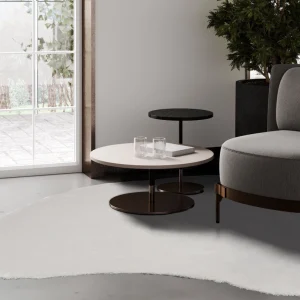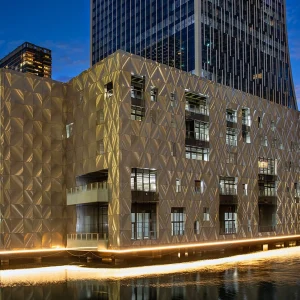
Words: Johnny Tucker
Jonathan Meades, writer and broadcaster, critic and raconteur, delights in life’s spice and the details that others miss, the spaces and events in between the big happenings that grab everyone’s attention. Known for his TV discourses and prose, he’s also a keen photographer with a magpie eye. Some of his most recent snaps — all taken on an HTC smartphone or pocket Sony digital camera — have just been published, not as a book, but as a box (a ‘boxette’, according to Meades) of 100 postcards entitled Pidgin Snaps.


© Jonathan Meades
The subject matter is suitably scattergun and often linked, mainly geographically, to projects he’s recently worked on. They are very much snaps. They are not great studies in photographic technical excellence, though some have been set up, particularly a number of the abstract liquid-marbling images. The other pictures range from abandoned vehicles to forests of road signs, from architecture with a capital A, such as an interior of Hopkins’ Westminster Tube station, to ‘hideous’ French bungalows, and from the view from a ferry to bucolic scenes of loveliness.


© Jonathan Meades
What really lifts this set of fairly disparate images to a new level is the device of turning them into postcards. Not only does this make you stop and look at each one, you can turn them over to find a series of captions and comments that range from the banal through the patently ludicrous to the preposterous-yet highly-credible. These little notes occasionally lift the cards into the realms of the sublime. The vast majority of the nutritional factoids and pithy ‘quotes’ are completely made up and so very well reflect the nature of Meades as a highly educated, impish bruiser, mixing high culture and low-brow language, scattering intermingled knowledge and mischievous confusion in his wake.


© Jonathan Meades
He wrote a piece for The Guardian on these postcards and littered that too with ‘facts’ that many will take at face value, but are completely fictitious: The ‘neeb’, he claims in the piece, is the quadrangle showing you where to affix your stamp and named after Dieter Neeb, a publisher from Fulda in Bavaria. It’s made more plausible by the ‘fact’ that until 1914, 70 per cent of the world’s postcards were made in this southern German town, or so he claims. The neeb is probably an internet fact by now, complete with its own Wikipedia page.

© Jonathan Meades

© Jonathan Meades
He clearly has a love of this cardboard ephemera, particularly mass-produced gallery memento takeaways, and those picturing French post-war architecture from Les Trente Glourieuses. He lives in L’Unité in Marseille (Le Corbusier, 1947) though that doesn’t make it into the 100 (‘it’s been over-photographed’).
This highly personal boxette brings together two of his loves: postcards and photography. He has many other loves of course, including ‘bestiality’, he quips, and happily that also doesn’t make an appearance here — though it does in his fiction, including Pompey. I caught up with him over a cup of coffee (me) and lapsang souchong tea (him) in a central London hotel right across from the editing suite where he was working on a cut of his latest TV outing, Concrete Poetry: Bunkers, Brutalism, Bloodymindedness, which is due to screen on BBC4 in February.


© Jonathan Meades
Easy-going and charming, his plummy drawl scattered with expletives entices you into his world of entwined fact and fiction. He’s personally very pleased with the postcards and begins to tell me why: ‘I’m not terribly well versed in the history of postcards, but I collect them. I have been to postcard fairs, but the prices are ludicrous, so I buy them in bulk in France in street markets. I buy postcards of all sorts, but particularly architectural ones. I buy postcards wherever I go, when I go to galleries for example — you can own a Holbein for a quid.
‘I have these wonderful transparent holders, which hang from a chandelier and they are double-sided and each side takes about 100 cards, and I’ve got boxes full as well. The Unité doesn’t have particularly high ceilings though, apart from in the double-height sections.
‘I also buy photography books. I’m very appreciative of photography like Bill Brandt’s, Joel Sternfeld’s, Tony Ray-Jones’ and Martin Parr’s, but I don’t know any thing about it. What’s more, I mistrust architectural photography — much of it is a lie.
‘The impetus for these pictures was when I got my first digital camera and I went into a car wash somewhere in Somerset or Devon and started taking picture of the rollers through the windows. I ended up with abstract expressionism without any pain. So I started taking photographs through car windscreens in rain storms and then I started effecting rainstorms by getting plastic bags and filling them with different colour liquids of different viscosities to get these marble effects. The image on the cover of the book is actually brake lights of the car in front of me in a rainstorm.

© Jonathan Meades
‘The subjects are inanimate things that take my fancy. I love rusting machinery — you can never go wrong with rust — but it’s not much photographed. I don’t understand that. There’s not much here that would be recognised as architecture. I like taking picture of the interstitial spaces — the areas in between the buildings. I find that really interesting. There’s a little bit of architecture, such as Westminster Station by Hopkins. It’s one of my favourite places in London. I mean the inside, not that bit on top — that’s reprehensible, making a nod to Norman Shaw’s New Scotland Yard and it doesn’t work.
‘An architect friend of mine told me I really should publish my pictures. I knocked ideas around with the publisher John Mitchinson and came up with this idea of the postcards. I like photography and I like postcards and they go together. This is a way of doing photographs in a more throwaway way that was possibly useful, but that was also not a book. Because it’s not a book you do have to look at them individually. That said, some of them you’re going to say: "Well, what the fuck is this?" and move on to the next.

© Jonathan Meades
‘It’s called Pidgin [Snaps] because pidgin is a kind of mongrel language; it’s a mongrel form, it’s not art photography. It’s not parody. I’m not attempting to do Parr’s Boring Postcard or something similar. This has an impurity to it, a flaw, which is something I always strive for. Purity is a bore — chastity is a bore. I spend hours fretting over a sentence that I’m writing, but with this stuff I don’t really give a toss. I just do it. If it works, fine, if it doesn’t, fine.
‘I have thousands of images and I chose these because they are ones I like myself, no other criteria. I don’t approve of second guessing — the idea very prevalent in television is that you have to think about your audience. I don’t give a fuck about the audience. They might be you, someone of my late mother’s age or anyone, and if you try and gauge an audience you’re lost. You just have to write, photograph and do everything for yourself and hope that someone else likes it.
‘These pictures are reflective of the films I’ve been doing, so there are a lot of Scottish wastes. In fact I was up in Lewis the other day and I did drive around to check there were still lots of vehicles sinking into the ground. They are still there, thank god, just a bit more rusty and slightly more sunken. One had disappeared; it wasn’t all that far from the track so I think someone had pulled it out. It was a cherry-coloured Austin Metro.
‘It’s truly extraordinary, I showed the film I was working on at Faclan, the Hebridean literary festival, and I expected to have an incredibly antagonistic audience, but they all loved it. It was actually saying something truthful about their island instead of just banging on about wonderful beaches and black pudding.
‘Some of the postcard captions are dead straightforward, some of it is comedy, and some of it is malicious and bitchy and in the worst possible taste. I did them very quickly; it’s much more perspiration than inspiration. We hadn’t really thought about the captions until quite late on in the process so they had to be done quite quickly. There are various quotes from made-up writers. The whole thing is a fabrication, everything about this is completely bogus. It’s a very peculiar thing to find oneself doing!’

© Jonathan Meades
At this point he grabs the boxette and start reminiscing: ‘This is something I was absolutely drawn to in Marseille and this one was my rather joyous Chrismas card a couple of years ago. That is around the corner from L’Unité and that is one of the few that is actually beautiful. It’s a very remote place almost into Lithuania. The nearest town was Druskininkai, which is a deeply strange spa town. There’s this chunk of late-Soviet architecture, which in the film I’ve done about it I call Leonid Brezhnev plays the sounds of Vegas.

© Jonathan Meades
‘That’s in western France and the film was about the American influence on France, which is absolutely palpable, but the French won’t acknowledge it. There is this kind of homestead mentality of building hideous bungalows which are all over France, mushrooming in a really bad way.
‘That is the cover of Pompey but it wasn’t taken in Portsmouth, I took it in Aberdeen. I particularly like this as it show the real grimness of north-east Scotland. It’s the nearest I’d ever get to social realism. It feels like it’s a different era up there.
‘I like these pictures for their own sake and I’m sure if I was a proper photographer I would dream up a manifesto and rationale, but since I’m not I don’t feel that I have to. I don’t know if people will send them but I hope so. One thing I should say about them is that they are extremely underpriced. It’s a good deal — they work out at about 15p each! In the National Gallery, postcards are a quid a piece or more.’
Both Meades and his postcard box, as it turns out, are very good value.





